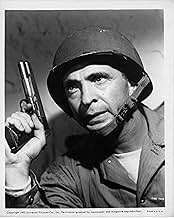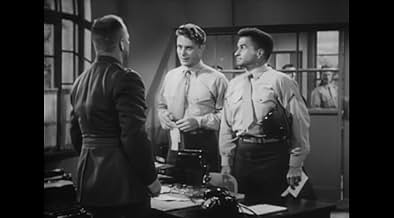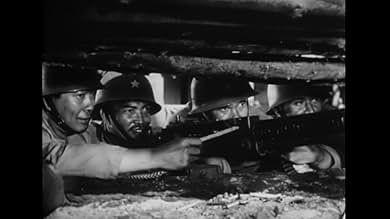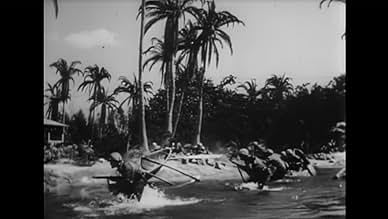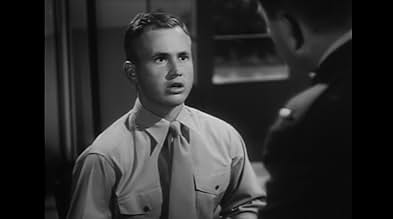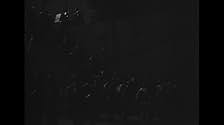The true story of Carlson's Raiders and their World War II attack on Makin Island.The true story of Carlson's Raiders and their World War II attack on Makin Island.The true story of Carlson's Raiders and their World War II attack on Makin Island.
- Director
- Writers
- Stars
- Harry - the Hamburger Man
- (uncredited)
- Chief Clerk
- (uncredited)
- Mess Boy
- (uncredited)
- Director
- Writers
- All cast & crew
- Production, box office & more at IMDbPro
Featured reviews
The second half involves a submarine ride and a raid on an island held by the Japanese. The action is surprisingly intense. Some scenes, like the shooting of Japanese out of trees reach the level of brutal poetic metaphor. These action scenes detail fierce fighting and are surprisingly even handed with both American and Japanese troops biting the dust pretty regularly.
Unlike, "Walk in the Sun" where the audience is given the chance to know and care about each soldier, there is only a pretty stereotyped introduction and then they are molded into one tough killing machine. The title "Gung Ho" we learn means "harmonious work" and that is what we get with precision maneuvers and no hesitation in the face of death on the battlefield.
One could call this communist propaganda, but without films like this, could fascism East and West have been defeated?
The real history behind this highly romanticized dramatization has been covered well by the other commentaries. The Makin Island raid was a folly that movie glamorizes, and Carlson was an idealist whose comrade-oriented methods had little influence on later commando tactics. However, even he didn't like the Hollywood result. Despite seeing his name on the credits and Randolph Scott ideally cast to portray him, Carlson walked out of the movie theatre in disgust when he first viewed the film.
When will this gem get remastered and restored? They truly don't make 'em like this anymore.
The film has been criticized for glamorizing what was essentially a band of cutthroats (Leonard Maltin even describes it as "a jaw-dropping experience"). Still, there was no doubt that any war picture made during this time wouldn't ram propagandist slogans down the audience's throat (witness Randolph Scott's final straight-into-camera speech); ironically, even if the latter was the film's nominal star, he's rarely involved in the action proper being there mainly to co-ordinate things, and repeatedly instigate his men to kill every Jap on the island!).
The supporting cast is good, made up of veteran character actors J. Carroll Naish, Sam Levene and newcomers notably Robert Mitchum; however, a fair share of the running-time is unwisely devoted to the romantic triangle involving a girl and two soldiers who happen to be half-brothers (one of them played by Noah Beery Jr.) all of which has a quite deadening effect on the main narrative! Despite being a relatively early WWII film, the action sequences are surprisingly gutsy though accentuated on occasion by obvious stock footage.
Randolph Scott plays a character based on Major Evans Carlson of Carlson's Raiders which was an elite unit of Marines trained to take the island. Carlson had seen service in China and was impressed with the Chinese guerrilla campaign against the Japanese there. He studied the tactics of Chu The who was the military commander of Mao Tse-tung's Chinese Communists. I don't know much Marxism, if any, Carlson took to heart, but after World War II it got him in no small amount of trouble. In an organization as conservative and tradition bound as the United States Marines he became a pariah. He died in 1951.
Since the Makin Island campaign was the start of our Pacific Offensive it was natural that Hollywood seized on the opportunity to make a quick B picture as a morale booster. Universal assembled a good cast that included a young Robert Mitchum before stardom. Besides Mitchum, I liked J. Carroll Naish and Sam Levene who gave good support to Scott. Levene played the typical serviceman from Brooklyn which by that time was becoming a cliché in war pictures.
Anyway Carlson's lasting contribution to the Marines was the phrase Gung Ho. So if you want to know how that got into the Marine vocabulary, see this movie.
Did you know
- TriviaHarold Landon, who plays Frankie Montana, relates that the actors who played Japanese soldiers were actually Filipino and Chinese.
- GoofsThe U.S. Marines were not issued Garand semi-automatic rifles in wide numbers until after the Guadalcanal invasion, so it might be thought that the Raiders would have been using M1903 Springfield bolt-action rifles in the Makin raid in August, 1942, which happened as the Guadalcanal campaign began. However, as James Roosevelt, the President's son, was a member of the raiding party, the 2nd Marine Raider Battalion, the unit in the raid, were issued the most up-to-date weaponry, which included Garands; the Makin raid was, in fact, one of the first combat deployments of the M1.
- Quotes
Lt.C.J.Cristoforos: A call has been issued by the commanding general for volunteers for a special battalion to be formed at once. Now this battalion will go into training for a particular combat duty overseas. Those men who can pass the severe requirements of this unit will be assured of immediate acts of service. The work involves close combat with the enemy, and only those men who are prepared to kill or be killed should apply. Those who accept it will be highly trained and will have every chance of survival. But it must be understood, the work is above and beyond the line of duty.
- Crazy creditsPrologue: "This is the factual record of the Second Marine Raider battalion, from its inception seven weeks after Pearl Harbor, through its first brilliant victory."
- ConnectionsFeatured in Hollywood Parade (1944)
- How long is 'Gung Ho!': The Story of Carlson's Makin Island Raiders?Powered by Alexa
Details
Box office
- Budget
- $866,898 (estimated)
- Runtime1 hour 28 minutes
- Color
- Aspect ratio
- 1.37 : 1
Contribute to this page


